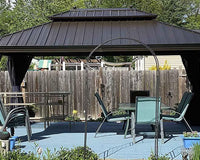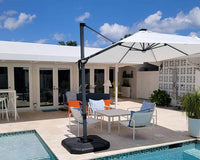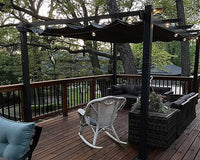Gathering under the shade of a patio umbrella is one of summer's simple pleasures, but even gentle breezes can transform into strong gusts that challenge your umbrella's staying power. Knowing when to close your patio umbrella is essential—not just to protect your investment but also to ensure the safety and comfort of your outdoor oasis. This guide will help you understand wind resistance, gauge safe wind speeds, and take preventative steps so you can relax without worry, no matter which way the wind blows.
The Role of Wind Resistance in Patio Umbrellas
Essentially, wind resistance is an umbrella's ability to withstand or repel the force exerted by the wind without toppling over or sustaining damage. Key to this resilience are materials like fiberglass for ribs, which flex rather than snap in gusts, and sturdy fabrics such as acrylic that can shrug off blustery challenges.
Designs also play a part; for instance, vented canopies allow air to pass through, reducing the chance of your umbrella taking flight. And then there's the wind rating—a metric some manufacturers provide based on tests that simulate various wind conditions. This rating helps you understand what weather your umbrella can handle, ensuring you're well-prepared for windy days.

Wind Resistance Ratings and Umbrella Durability
Usually just looking at the tag or manual that came with your patio umbrella will help you find its wind resistance rating; manufacturers may outline the highest wind speed they can handle. Should this information not be easily accessible, a brief call or email to the manufacturer will provide this vital knowledge. Key is to know when wind overwhelms your umbrella; indicators include excessive tilting, loud flapping of cloth, and clear rib or support pole bending.
Different umbrella varieties have somewhat different durability. With their basic form, market umbrellas can feature an aluminum pole down the middle, which can provide some strength but would suffer in strong gusts without appropriate anchoring. Cantilever umbrellas, on the other hand, suspend the canopy away from the base, giving them a larger area that can catch the wind like a sail—though they often come with robust bases and frames designed to counteract this effect. Knowing the wind resistance qualities of any type you own can help to maintain the calm and safety of your outside area.
Measure Wind Speed and Its Impact on Umbrellas
Wind speed is scientifically measured using an instrument called an anemometer, which captures air movement and translates it into a reading often expressed in miles per hour (mph). When wind encounters a patio umbrella, several aerodynamic forces come alive. Lift and drag are the main actors here; lift wants to pull your umbrella skyward, while drag aims to push it sideways with the wind's direction.
In everyday terms, think of your umbrella as a boat sail. Just as a sail catches the wind to propel a boat, your open umbrella can catch wind, potentially causing it to become unstable or even take off. The design of the umbrella influences this interaction—those with vents act like a ship's sails that can be adjusted for wind conditions, letting some air pass through to minimize the risk of an 'umbrella voyage,' keeping it more grounded during those blustery moments.
When to Fold Patio Umbrellas
Generally speaking, patio umbrellas should be closed when wind speeds approach or surpass 20–24 mph—often the case when a mild breeze evolves into a severe wind. Differentiating between sustained winds—which are consistent and constant over a period—and gusts—which are sudden bursts of high speed is crucial. Particularly dangerous are gusts, as they might surprise you and start damage right away.
Manufacturers typically provide guidelines on what their umbrellas can endure—usually within the product manual or upon inquiry. For safety organizations, they echo the caution, advocating for an even more conservative approach; if the wind feels too brisk for comfort, it's safer to err on the side of caution and close your umbrella. Each product will have its threshold, but personal safety and care for your property should always come first.
Innovations in Umbrella Windproofing
Modern umbrellas often come equipped with features specifically engineered for wind resistance. Vented canopies are a prime example; these smart designs incorporate strategic openings that allow wind to flow through without lifting the entire structure. Think of them as pressure release valves that reduce the "balloon effect" often responsible for umbrella mishaps.
Materials such as fiberglass flex under pressure, providing a buffer against strong winds that would typically snap rigid materials. Additionally, heavy-duty bases anchor these umbrellas firmly to the ground, countering the lift and drag forces by adding gravitational stability.
Whether it's a weighted foundation, a safe planter, or a mount in your patio table, proper anchoring—along with careful placement, sheltered from prevailing winds—are fundamental practices that work hand-in-hand with technological improvements to maintain your shaded hideaway both calm and safe.

Proactive Protection for Your Patio Umbrella
Start by regularly checking your local weather forecast to stay ahead of any windy conditions that could be on the horizon. If strong winds are predicted, it’s wise to close your umbrella in advance.
Closing an umbrella properly involves more than just collapsing the canopy; ensure it’s securely fastened with ties or Velcro straps to prevent it from unfurling. If your model has a telescopic pole, lower it to reduce its profile and minimize exposure to the wind. After closing, if possible, remove the umbrella from its base and store it in a sheltered area to avoid any wind interaction altogether.

Frequent maintenance should cover looking for loose screws or worn-out components that can compromise stability, making sure the cloth is whole without tears, and confirming that the opening mechanism runs without problems. Review your umbrella carefully at the beginning of every season—tightening, repairing, and lubricating as needed—to strengthen its protection against the vagaries of the elements.





1 comment
Krish Pillai
I recently bought a purple leaf 3.65 × 3.65 parasol. Is it fine to peg the 4 corners loosely via anchored road to help protect the parasol from wind damage